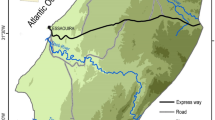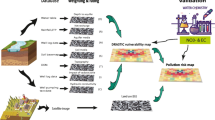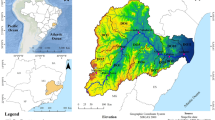Abstract
Assessing the degree of vulnerability of surface water intended for drinking water supply has become a major necessity in water resource management and decision-making; it allows to identify high-risk areas and provide all the necessary measures for its protection. Specialized analysis techniques using geographic information systems (GIS) and remote sensing are increasingly being used to qualitatively assess this vulnerability. For his purpose, the aim of this study is to present the results of the application of the “DKPR” approach for evaluating of the degree of vulnerability that concerns water contamination of the Ghiss dam sub-watershed, a hydraulic structure under construction to ensure the supply of drinking water to the city of Al Hoceima and the surrounding centers, as well as the protection of the downstream area against floods generated during the Ghiss river floods. The latter drains agricultural plots, natural areas, uncultivated land, and rural settlements. The approach adopted involves four parameters: accessibility of the aquatic environment (D), soil and subsoil water functioning (K), watershed physiography (P), and rainfall erosivity (R). The final result is a map obtained by additionally combining the index maps of these four parameters. The overall vulnerability index obtained by this combination varies in a range of values from 0 to 4 and is divided into five classes of vulnerability ranging from “very low” to “very high.” The results achieved show that the Ghiss dam sub-watershed is dominated by the moderate vulnerability class. It occupies 59.63% of the total area of the sub-watershed studied.







Similar content being viewed by others
References
Afilal F, Draoui M, El Messari JS (2018) Application of the DKPR method for mapping vulnerability to contamination of water Smir’s River Dam (North Morocco). J Water Sci Environ Technol 2(2):402–410
Agency of the hydraulic basin of loukkos (2005) Etude d’actualisation du Plan Directeur D’Aménagement Intégré des Ressources en Eau des bassins Loukkos, Tangérois et Côtiers méditerranéens. Mission 1 : Analyse et synthèse des connaissances actuelles dans le domaine des ressources en eau évaluation et prévision des besoins et des demandes en eau. Sous-mission 1.1: Analyse et synthèse des connaissances actuelles dans le domaine des ressources en eau - Ressources en eau souterraines. Maroc, 123p
Anandhi A, Kannan N (2018) Vulnerability assessment of water resources-translating a theoretical concept to an operational framework using systems thinking approach in a changing climate: case study in Ogallala Aquifer. J Hydrol 557:460–474. https://doi.org/10.1016/j.jhydrol.2017.11.032
Andrieux J (1971) La structure du Rif central: étude des relations entre la tectonique de compression et les nappes de glissement dans un tronçon de la chaîne alpine. Notes Mém Services Géol 235:155
Arrebei N, Sabir M, Naimi M, Chikhaoui M, Raclot D (2019) Reconstitution des données historiques et diagnostic de l’état actuel des aménagements antiérosifs dans le bassin versant Nekor. Moroccan J Agron Vet Sci 7(2):287–306
Bhateria R, Jain D (2016) Water quality assessment of lake: a review. Sustain Water Resour Manag 2(2):161–173. https://doi.org/10.1007/s40899-015-0014-7
Bollinger JE, Steinberg LJ, Harrison MJ, Crews JP, Englande AJ, Velasco-Gonzales C, White LE, George WJ (1999) Comparative analysis of nutrient data in the lower Mississippi River. Water Res 33(11):2627–2632
Chalouan A (1986) Les nappes Ghomarides (Rif Septentrional, Maroc), un terrain varisque dans la chaîne alpine. Thèse de doctorat en Géologie, 317, Université Louis Pasteur Strasbourg I France
Chhetri R, Kumar P, Pandey-Vishnu P, Singh R, Pandey S (2020) Vulnerability assessment of water resources in Hilly Region of Nepal. Sust Water Resourc Manag 6(3):34. https://doi.org/10.1007/s40899-020-00391-x
De Ketelaere D, Daly D (2004) Hazard mapping - vulnerability in a risk framework. Vulnerability and risk mapping for the protection of carbonate (karst) aquifers:84-86
Didon J, Durand-Delga M, Kornprobst J (1973) Homologies géologiques entre les deux rives du détroit de Gibraltar. Bull Soc Géol France S7-XV(2):77–105. https://doi.org/10.2113/gssgfbull.s7-xv.2.77
Douay D, Lardieg E (2010) Délimitation des aires d’alimentation des captages prioritaires du bassin Adour Garonne : méthodologie de cartographie de la vulnérabilité intrinsèque des captages d’eau superficielle. Agence de l’Eau ADOUR - GARRONE, ANTEA -GINGER Environnement & Infrastructures – CALLIGEE, 28p
Du Plessis A (2017) Freshwater challenges of South Africa and its upper Vaal River: current state and outlook (Springer WATER). Springer, Cham Switzerland
Durand-Delga M (1972) La courbure de Gibraltar, extremite occidentale des chaines alpines, unit l’Europe et l’Afrique. Eclogae Geol Helv 65(2):267–278
Durand-Delga M, Gardin S, Olivier P (1999) Datation des flyschs éocrétacés maurétaniens des Maghrébides: la formation du Jbel Tisirène (Rif, Maroc). Comptes Rendus de l’Académie des Sciences. Series IIA - Earth Planet Sci 328(10):701–709. https://doi.org/10.1016/S1251-8050(99)80180-3
Gavrilovic S (1962) A method for estimating the average annual quantity of sediments according to the potency of erosion. Faculty Forestry 26:151–168
Herhar L ( 2016) Cartographie de la vulnérabilité à la contamination des eaux du barrage de l’oued martil (Maroc septentrional) et contribution à l’établissement de la carte de risque. Thèse de doctorat en Géologie, 230p, Université Abdelmalek Essadi Maroc
Herhar L, El Messari JS, Draoui M (2018) La cartographie de la vulnérabilité à la contamination des eaux de surface du bassin versant du Barrage de l’Oued Martil. Int J Innov Appl Stud 23(4):598–605
Hilal I (2017) Protection des eaux superficielles par cartographie du risque à la contamination: Cas du barrage 9 Avril 1947 (Nord Maroc).Thèse de doctorat en Géologie, 229p, Université Abdelmalek Essadi Maroc
Hilal I, El Messari JS, Moreno Navarro JG, Mansour MRA, Hassani Zerrouk M (2018) Application du modèle DKPR pour la cartographie de la vulnérabilité des eaux de surface à la contamination: cas du barrage 9 avril 1947 (Maroc septentrional). Revue Sci l'eau 31(1):75–86. https://doi.org/10.7202/1047054ar
Jabbar FK, Grote K (2020) Evaluation of the predictive reliability of a new watershed health assessment method using the SWAT model. Environ Monit Assess 192(4):224. https://doi.org/10.1007/s10661-020-8182-9
Kouz T, Cherkaoui Dekkaki H, Mansour S, Hassani Zerrouk M, Mourabit T (2017) Application of GALDIT index to assess the intrinsic vulnerability of coastal aquifer to seawater intrusion case of the Ghiss-Nekor Aquifer (North East of Morocco). In: Calvache M, Duque C, Pulido-Velazquez D (eds) Groundwater and global change in the western Mediterranean area. Environmental earth sciences. Springer, Cham, pp 169–177. https://doi.org/10.1007/978-3-319-69356-9_20
Kouz T, Mansour S, Mourabit T, Cherkaoui Dekkaki H (2019) Application of the “PRK Plus” approach to evaluate the sensitivity of the coastal aquifer of Ghiss-Nekkour against pollution (North East of Morocco). La Houille Blanche 5–6:16–25. https://doi.org/10.1051/lhb/2019052
Kouz T, Mansour S, Mesmoudi H, Dakkak H, Cherkaoui Dekkaki H (2020) Assessment of groundwater vulnerability to pollution as part of integrated management in coastal area. Case of Ghiss-Nekkour basin (North East of Morocco). La Houille Blanche 2:63–73. https://doi.org/10.1051/lhb/2020019
Mazzourh A, Ouhadi A (2019) Etude de la salinisation des eaux souterraines en zone côtière moyennant le SIG et la Télédétection. Cas de la nappe de Ghiss - Nekkour autour de la faille de Trougout. Mémoire de projet de fin d’études de Master, 63 , Université Abdelmalek Essaadi Maroc
Metcalfe C, Guppy L, Qadir M (2017) Global barriers to improving water quality: a critical review. United Nations University Institute for Water, Environment and Health
Michard A, Chalouan A, Feinberg H, Goffé B, Montigny R (2002) How does the Alpine belt end between Spain and Morocco. Bull Soc Géol France 173(1):3–15. https://doi.org/10.2113/173.1.3
Michard A, Negro F, Saddiqi O, Bouybaouene ML, Chalouan A, Montigny R, Goffé B (2006) Pressure-temperature-time constraints on the Maghrebide mountain building: evidence from the Rif-Betic transect (Morocco, Spain), Algerian correlations, and geodynamic implications. Compt Rendus Geosci 338(1–2):92–114. https://doi.org/10.1016/j.crte.2005.11.011
Michard A, Saddiqi O, Chalouan A, Lamotte DF (eds) (2008) Continental evolution: the geology of Morocco: structure, stratigraphy, and tectonics of the Africa-Atlantic-Mediterranean triple junction. Series Lect Notes Earth Sci 116:444
Niazi S, Snoussi M, Foutlane A (2005) Impact des aléas climatiques sur la qualité des eaux d’un hydrosystème aménagé en zone semi-aride : cas du bassin-versant du Nekkor (Maroc). Sécheresse (Montrouge) 16(3):183–187
Orhon L (1993) Influence de la distance des épandages au ruisseau collecteur sur le transfert par ruissellement des pesticides. Mémoire de DEA, École Nationale de Santé Publique France
Poujol A (2014) Analyse des déformations actuelles dans le Rif (Maroc) : approche morphotectonique. Thèse de doctorat en Géologie, 373, Université Montpellier II - Scienes and Techniques of Language France
Priority Actions Program Regional Activity Center (PAP/RAC) (1997) Split, Mediterranean Action Plan UNEP in cooperation with FAO Guidelines for mapping and measurement of rainfall induced erosion processes in the Mediterranean coastal area, 72p
Renard KG, Foster GR, Weesies GA, Porter JP (1991) Revised universal soil loss equation. J Soil Water Conserv 46(1):30–33
Renard KG, Foster GR, Weesies GA, McCool DK, Yoder DC (1997) Predicting soil erosion by water: a guide to conservation planning with the Revised Soil Loss Equation (RUSLE) – agriculture handbook No. 703. USDA, Washington
Renard KG, Freimund JR (1994) Using monthly precipitation data to estimate the R-factor in the revised USLE. J Hydrol 157(1–4):287–306. https://doi.org/10.1016/0022-1694(94)90110-4
Roose E (1991) Conservation des sols en zones méditerranéennes - Synthèse et proposition d’une nouvelle stratégie de lutte antiérosive: la CGES. Cahiers ORSTOM. Série Pédologie XXVI(2):145–181
Roose E (1997) Protection des terres et gestion du ruissellement à l’amont d’un lac collinaire en zone méditerranéenne semi-aride : étude bibliographique pour le projet HYDROMED. ORSTOM Montpellier, 33 p
Saaty TL (1980) The analytic hierarchy processes. McGraw-Hill, New York
Salhi A (2008) Géophysique, hydrogéologie et cartographie de la vulnérabilité et du risque de pollution de l’aquifère de Ghis-Nekor, Al Hoceima. Thèse de doctorat d'état en Géologie, 270, Université Abdelmalek Essadi Maroc
Sánchez E, Colmenarejo MF, Vicente J, Rubio A, García MG, Travieso L, Borja R (2007) Use of the water quality index and dissolved oxygen deficit as simple indicators of watershed pollution. Ecol Indic 7(2):315–328. https://doi.org/10.1016/j.ecolind.2006.02.005
Simeonov V, Stratis JA, Samara C, Zachariadis G, Voutsa D, Anthemidis A, Sofoniou M, Kouimtzis T (2003) Assessment of the surface water quality in Northern Greece. Water Res 37:4119–4124. https://doi.org/10.1016/S0043-1354(03)00398-1
Singh S, Hassan SMT, Hassan M, Bharti N (2019) Urbanization and water insecurity in the Hindu Kush Himalaya: insights from Bangladesh, India, Nepal and Pakistan. Water Policy 22(S1):9–32. https://doi.org/10.2166/wp.2019.215
Thanh NT (2019) Evaluation of multi-precipitation products for multi-time scales and spatial distribution during 2007–2015. Civil Eng J 5(1):1–13
Vasistha P, Ganguly R (2020a) Water quality assessment of natural lakes and its importance: an overview. Mater Today 32:544–552. https://doi.org/10.1016/j.matpr.2020.02.092
Vasistha P, Ganguly R (2020b) Assessment of spatio-temporal variations in lake water body using indexing method. Environ Sci Pollut Res 27(33):41856–41875. https://doi.org/10.1007/s11356-020-10109-3
Versari A, Parpinello GP, Galassi S (2002) Chemometric survey of Italian bottled mineral waters by means of their labelled physico-chemical and chemical composition. J Food Compos Anal 15:251–264. https://doi.org/10.1006/jfca.2002.1058
Wischmeier WH, Smith DD (1978) Predicting rainfall erosion losses - a guide to conservation planning. In: Agriculture handbook, vol 537. Department of Agriculture Science and Education Administration, Washington, p 58
Acknowledgements
The authors of this work would like to thank all the people who contributed directly or indirectly to its realization. More particularly, the authors are thinking of the managers and directors of the Loukkos River Basin Agency (Tetouan), as well as the managers and directors of the National Institute for Agronomic Research (Rabat), for their great collaboration and the provision of all the data sought.
This work is an extract from the current thesis entitled: Vulnerability of dam catchment basins and their exposure to risks. Case of the Ghiss-Nekkour coastal hydrological basin, an axis of the framework programme: Integrated management of coastal basins. Application case at the Ghiss-Nekkour basin level. Which thesis is being prepared by the PhD student S. Mansour. It is directed by professor Hinde Cherkaoui Dekkaki.
This project is not financed. It is supported by the Laboratory of Research and Development in Engineering Sciences, Department of Earth and Environmental Sciences, Faculty of Science and Technique of Al Hoceima (FSTH), Abdelmalek Essaadi University.
Author information
Authors and Affiliations
Contributions
Conceptualization, methodology, writing—original draft preparation: Soukaina Mansour; visualization, investigation: Taoufiq Kouz; visualization: Mohammed Thaiki; visualization: Abdellah Ouhadi; resources, survey: Hakim Mesmoudi; visualization: Mohammed Hassani Zerrouk; visualization: Taoufik Mourabit; resources, survey: Houria Dakak; project administration, supervision, writing—revision: Hinde Cherkaoui Dekkaki.
Corresponding author
Ethics declarations
Conflict of interest
The authors declare that they have no competing interests.
Additional information
Responsible Editor: Broder J. Merkel
Resubmitted to Arabian Journal of Geosciences 2021.
Appendix
Appendix
Rights and permissions
About this article
Cite this article
Mansour, S., Kouz, T., Thaiki, M. et al. Spatial assessment of the vulnerability of water resources against anthropogenic pollution using the DKPR model: a case of Ghiss-Nekkour basin, Morocco. Arab J Geosci 14, 699 (2021). https://doi.org/10.1007/s12517-021-06973-z
Received:
Accepted:
Published:
DOI: https://doi.org/10.1007/s12517-021-06973-z




